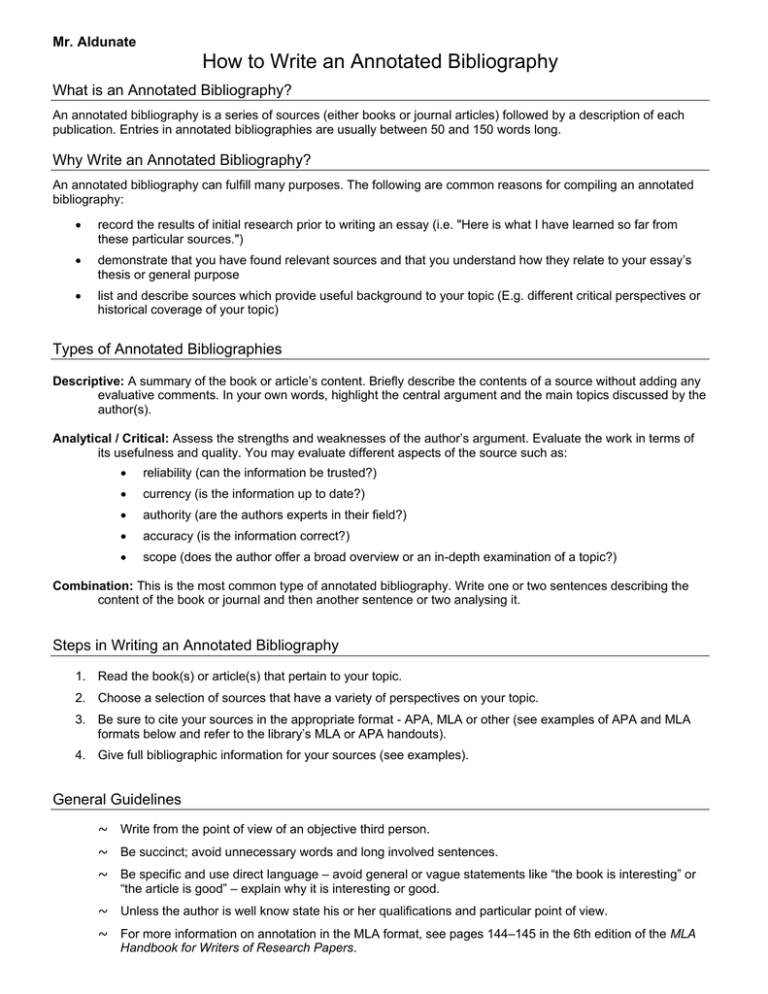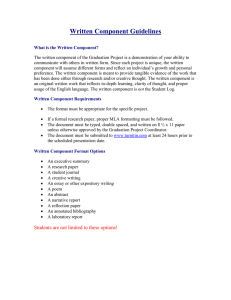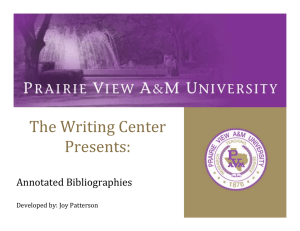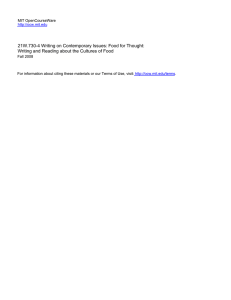How to Write an Annotated Bibliography What is an Annotated Bibliography?
advertisement

Mr. Aldunate How to Write an Annotated Bibliography What is an Annotated Bibliography? An annotated bibliography is a series of sources (either books or journal articles) followed by a description of each publication. Entries in annotated bibliographies are usually between 50 and 150 words long. Why Write an Annotated Bibliography? An annotated bibliography can fulfill many purposes. The following are common reasons for compiling an annotated bibliography: record the results of initial research prior to writing an essay (i.e. "Here is what I have learned so far from these particular sources.") demonstrate that you have found relevant sources and that you understand how they relate to your essay’s thesis or general purpose list and describe sources which provide useful background to your topic (E.g. different critical perspectives or historical coverage of your topic) Types of Annotated Bibliographies Descriptive: A summary of the book or article’s content. Briefly describe the contents of a source without adding any evaluative comments. In your own words, highlight the central argument and the main topics discussed by the author(s). Analytical / Critical: Assess the strengths and weaknesses of the author’s argument. Evaluate the work in terms of its usefulness and quality. You may evaluate different aspects of the source such as: reliability (can the information be trusted?) currency (is the information up to date?) authority (are the authors experts in their field?) accuracy (is the information correct?) scope (does the author offer a broad overview or an in-depth examination of a topic?) Combination: This is the most common type of annotated bibliography. Write one or two sentences describing the content of the book or journal and then another sentence or two analysing it. Steps in Writing an Annotated Bibliography 1. Read the book(s) or article(s) that pertain to your topic. 2. Choose a selection of sources that have a variety of perspectives on your topic. 3. Be sure to cite your sources in the appropriate format - APA, MLA or other (see examples of APA and MLA formats below and refer to the library’s MLA or APA handouts). 4. Give full bibliographic information for your sources (see examples). General Guidelines ~ Write from the point of view of an objective third person. ~ Be succinct; avoid unnecessary words and long involved sentences. ~ Be specific and use direct language – avoid general or vague statements like “the book is interesting” or “the article is good” – explain why it is interesting or good. ~ Unless the author is well know state his or her qualifications and particular point of view. ~ For more information on annotation in the MLA format, see pages 144–145 in the 6th edition of the MLA Handbook for Writers of Research Papers. Mr. Aldunate Examples of Annotated Bibliography Entries NOTE: An annotated bibliography should be double-spaced and use a 12-point font. These examples are using a 10 pt. font and 1.5 line spacing. APA – Book (Type = Descriptive) NOTE: In APA, begin annotation on a new line following the citation. Taylor, M., & Leicester, M. (1992). Ethics, ethnicity and education: A new perspective. Bristol, PA: Taylor and Francis. This book is an important and inherently controversial collection of papers that discusses the major moral issues in ¾” multicultural school education. Topics discussed include the ethical aspects of the separate schools debate, strategies for establishing democratic school and preparing teachers to be more moral educators, and consideration of the values implicitly antiracist / multicultural education. APA – Article (Type = Combination) London, H. (1982). Five myths of the television age. Television Quarterly, 10(1), 81–89. Herbert London, the Dean of Journalism at New York University and author of several books and articles, explains how television contradicts five commonly believed ideas. He uses specific examples of events seen on television, ¾” such as the assassination of John Kennedy, to illustrate his points. London uses logical arguments to support his ideas, which are his personal opinion. He doesn't refer to any previous works on the topic; however, for a different point of view, one should refer to Joseph Patterson's, "Television is Truth" (The Journal of Television, 45(6) November/December 1995: 120-135). London's style and vocabulary would make the article of interest to any reader. The article clearly illustrates London's points, but does not explore their implications, leaving the reader with many unanswered questions. MLA – Book (Type = Descriptive) NOTE: In the MLA style, begin annotation where the citation ends. Zinn, Howard. A People's History of the United States. New York: New Press, 1999. In this book the history of the United States is seen from the viewpoint of people who were not necessarily beneficiaries of American democracy. The book concentrates on the experiences of slaves, American Indians, women, and other disenfranchised groups and how they ½” were affected by the major events in American history. Zinn emphasizes in the introduction that his intent is not to demonize figures such as revolutionary leaders, but to portray them in a more realistic light, as people who, while contributing to the development of the United States, were influenced by the prejudices of their time. As a source of information that is usually not included in history books, A People's History of the United States is invaluable to the study of American History. MLA – Article (Type = Combination) McEwan, Cheryl. "Paradise or Pandemonium? West African Landscapes in the Travel Accounts of Victorian Women." Journal of Historical Geography 22.1 (1996): 68-83. McEwan analyses four 19th century British women travel writers’ geographical descriptions of African landscapes to determine how these images were influenced or challenged by the British myth of the "Dark Continent." Further, McEwan argues that two factors, the developing British ideology of imperialism and the romanticism of the concepts of "wilderness" and "sanctuary," influenced these landscape ½” descriptions. Though McEwan adequately explores the regional and temporal contexts influencing the four authors’ geographical descriptions, she does not directly address the relationships among these accounts, nor make a strong case for their influence on British imperialistic public policy. However, McEwan does establish the broad popular interest in European explorer's travel accounts and their power to influence British perceptions of Africa and Africans, suggesting a plausible correlation between public perception and British imperialistic policy. Sources: http://www.mhc.ab.ca/library/howtoguides.html http://www.utm.utoronto.ca/library/instruction/howtowritebiblio.html



